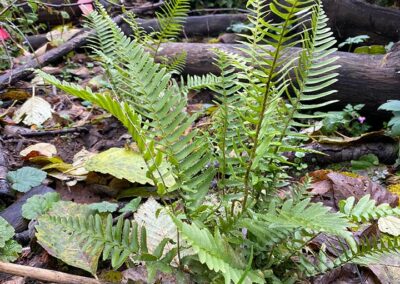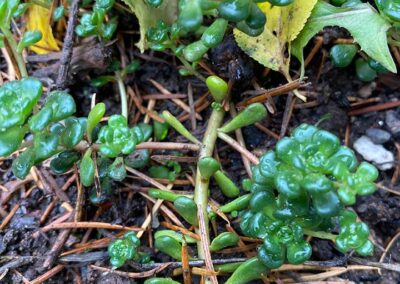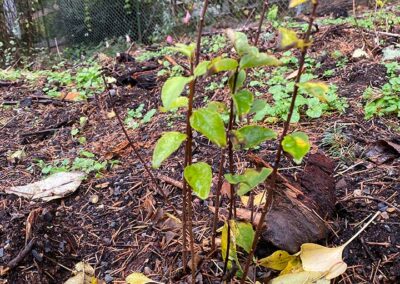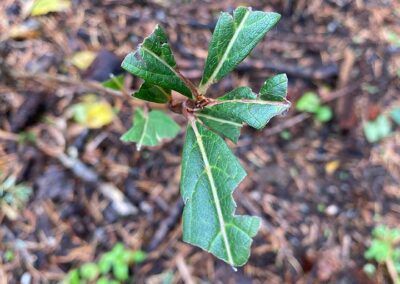In the heart of Leach Back 5, a transformative project is taking root, bringing forth a burst of life and biodiversity that promises to reshape the landscape. In October, a dedicated group of volunteers planted 120 native plants, a diverse mix that includes Black twinberry, mock orange, sword ferns, oceanspray, oreganum (Oregon stonecrop), and serviceberry. Each of these plant species plays a unique role in enhancing the ecological balance and promoting a thriving habitat. In this blog post, we delve into the benefits and significance of these new additions, shedding light on the beauty of biodiversity and its positive impact on local ecosystems.
1. Black twinberry (Lonicera involucrata): A Berry-Laden Haven
The Black twinberry, with its vibrant clusters of dark berries, is a standout addition to Leach Back 5. Beyond its aesthetic appeal, this native shrub serves as a crucial food source for birds and mammals. The berries, rich in nutrients, attract a variety of wildlife, contributing to the overall biodiversity of the area. Additionally, the Black twinberry plays a role in supporting local insect populations, providing a sustainable ecosystem that benefits both flora and fauna.
2. Mock orange (Philadelphus lewisii): Fragrance and Functionality
As the volunteers planted the Mock Orange, the air in Leach Back 5 became infused with a sweet, citrusy fragrance. This native shrub not only adds olfactory delight to the surroundings but also serves as a valuable habitat for pollinators. Bees, butterflies, and other pollinating insects are drawn to the fragrant blossoms, ensuring the continued reproduction of plant species in the area. The Mock Orange exemplifies how aesthetics and functionality can harmoniously coexist in a carefully curated natural space.
3. Sword ferns (Polystichum munitum): Lush Foliage for a Shaded Oasis
In all corners of Leach Back 5, sword ferns find their home. These graceful ferns, with their feathery fronds, add a touch of elegance to the landscape. Beyond their visual appeal, sword ferns play a crucial role in creating microhabitats within the dense vegetation. These areas become havens for small animals, insects, and amphibians, fostering a thriving ecosystem even in the cooler, shadier sections of the project site.
4. Oceanspray (Holodiscus discolor): Cascading Beauty and Ecosystem Benefits
The Oceanspray, with its delicate, cascading branches, is a picturesque addition to Leach Back 5. This native shrub not only contributes to the visual diversity of the landscape but also offers practical benefits. Oceanspray provides habitat and food for various insects and birds, creating a web of interconnected relationships within the ecosystem. As these shrubs mature, their branches will serve as shelter for nesting birds, completing the cycle of life in this rejuvenated space.
5. Oregon Stonecrop (Sedum oreganum): Resilience in a Compact Package
Sedum oreganum, commonly known as Oregon Stonecrop, is a resilient ground cover that brings a touch of greenery to Leach Back 5. Its low-growing habit helps control soil erosion, stabilizing the landscape. Beyond its ecological benefits, Oregon Stonecrop has a history of ethnobotanical uses. Indigenous communities traditionally utilized this plant for medicinal purposes, highlighting the interconnectedness of nature and human well-being.
6. Serviceberry (Amelanchier alnifolia): A Multifaceted Marvel
Among the 120 plants that found a new home in Leach Back 5, Serviceberry stands out as a multifaceted marvel. Not only does it contribute to the overall beauty of the area with its delicate blooms, but it also provides edible fruit, attracting wildlife and supporting local biodiversity. Birds, pollinators, and pest-eating insects are drawn to the Serviceberry, creating a dynamic and sustainable ecosystem. Additionally, Serviceberry has historical ethnobotanical uses, showcasing its cultural significance and deep-rooted connections with human communities.
Cultivating Diversity for a Sustainable Future
As the project in Leach Back 5 unfolds, the impact of these carefully chosen native plants becomes increasingly apparent. A portion of the Back 5 will be transformed into a meadow, while the remaining area will undergo restoration to become a mixed conifer forest. Previously dominated by blackberry and ivy, the landscape now boasts increased biodiversity as part of the restoration efforts. The success of this project serves as a testament to the power of ecological restoration and the importance of cultivating diversity in our natural spaces. The 120 plants, each with its unique qualities, contribute to the intricate tapestry of life in Leach Back 5, promising a sustainable and thriving future for this rejuvenated landscape.









